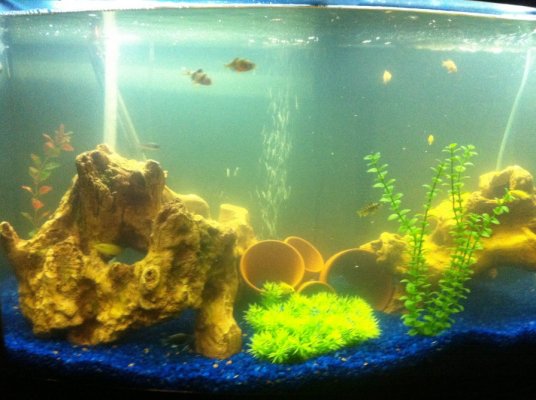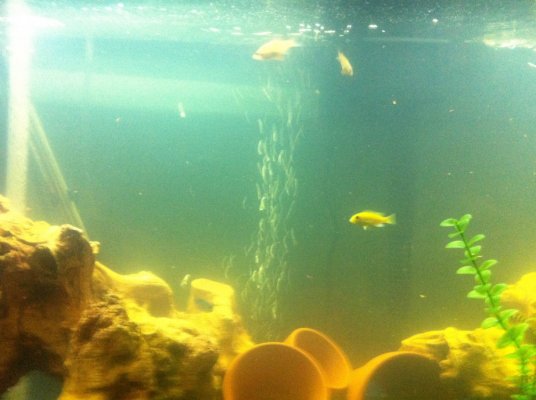okay I got home and here is the exact levels...
I went out and bought the Freshwater Master Test Kit so that I can test everything...
I also bought a UV filter that someone suggested, it is helping some...
Temp: 78
Ammonia, NH4: 8.0
Nitrates, NO3: 0
Nitrates, NO2: 0.25
pH:8.2
What else do I need to do, is my Ammonia high?
Are you sure you are testing Ammonia NH4 and not NH3? NH4 (Ammonium) is usually present when the PH is below 7.0 and is not toxic to the fish. The higher PH suggests NH3 Ammonia which is toxic. There is a difference here as to whether to panic or not panic based on which one you are testing.

To address a number of the posters on this thread, for years, DECADES actually, tanks have been cycled with fish in them so the severity of this situation is not catastrophic and can be managed without panic.
Drastic water changes will do almost as much damage to the fish as the readings will. Daily partial water changes of about 15%-20% of volume will get the tank back into shape much more safely. Use of any chemicals besides dechlorinator or chloramine remover is not advised. The product "Prime" is a good product to use to help keep the ammonia in NH4 form. Adding more oxygen via airstones or live plants will help provide the fish more breathable oxygen should their gills be effected with ammonia burns.
The fastest way to finish cycling your tank, now that the fish are in it, is to add from an established tank, either some filter media or gravel. This will contain the nitrifying bacteria needed to "cycle" the aquarium. At this point, the Nitrites are not toxic (but will climb to toxic levels quickly if left unchecked) and the simple fact that nitrites are present means that the ammonia level is starting to go down even if you do no water changes (which at this point is NOT recommended. Do them!!!)
As for the UV sterilizer, I would not advise using it until you have an established biological filter in your tank and your levels are at 0. Until the nitrifying bacteria get established, it is possible for them to be "floating" in the water and being killed off by the sterilizer. In an established aquarium, blooms like yours usually end in a day or 2. (The chemical you are using might be adding to this bloom so I would stop using it for now.) If you do get some established media, Definitely turn off the UV.
The best thing you can do now is observe your fish. If you see them having problems (after doing daily water changes)and you don't have another tank to put them in, you'd be best to get a bucket of new water and an airstone, using the same PH and Temp of their tank and acclimate the fish into this bucket. This way the fish are in clean water and out of danger. This water will need to be changed every other day and feeding should be extremely cut back or even eliminated to prevent any ammonia creation other than from normal respiration. Once the fish are removed from their tank, you can either let the tank finish cycling ( which it will do faster now with no new ammonia being produced) or do a 90%-100% water change to reduce the ammonia and nitrite levels. If you do the water change, daily ammonia readings will need to be taken once the fish are put back into the tank to prevent the level from getting toxic. Partial water changes will be needed to do this and the results will be a longer cycling period.
To simplify the "cycling" process, when your ammonia and nitrite levels go from 0 to up then back down to 0, there is enough nitrifying bacteria present to handle the bioload in the tank at the time of the second 0 reading. Since you don't have 0 readings and your bioload (fish) hasn't shrunk, when you put the fish back into the tank after doing the 100% water change, you are starting back at the first 0. By letting the tank finish cycling on it's own, you are creating a stronger bacteria bed that can handle your present load. Both ways can be done so the choice is yours.

To address BeehPee's concerns, I have to agree that some of the posts on this thread were not really necessary or of consequence. Tank size and bioload are not really as important at this point as the ammonia and nitrite readings. An overstocked tank will still cycle. It will just take longer. Talk about the overstoking AFTER this situation has resolved. (IMO)
Hope some of this helps...

 Introuble
Introuble 


